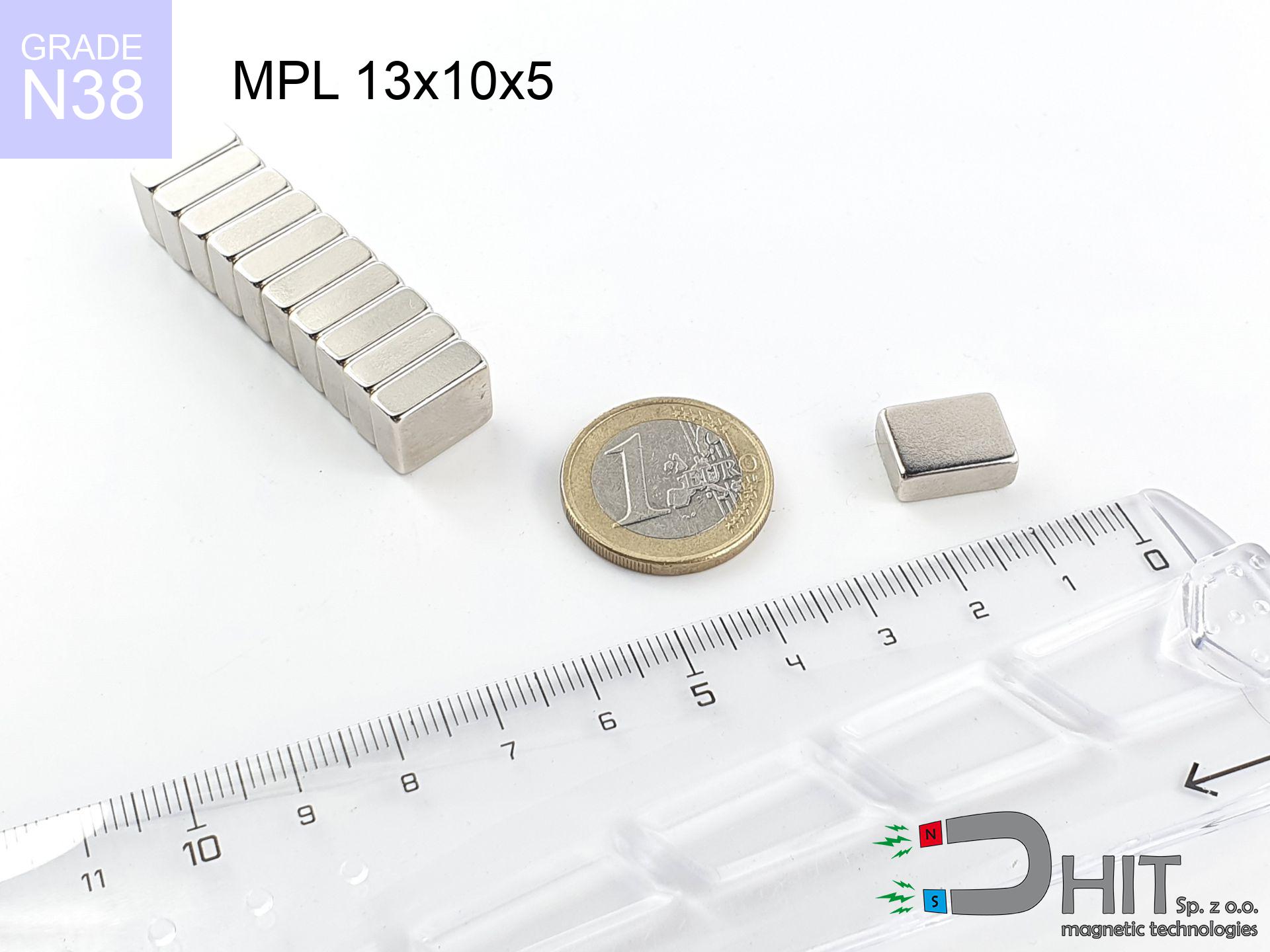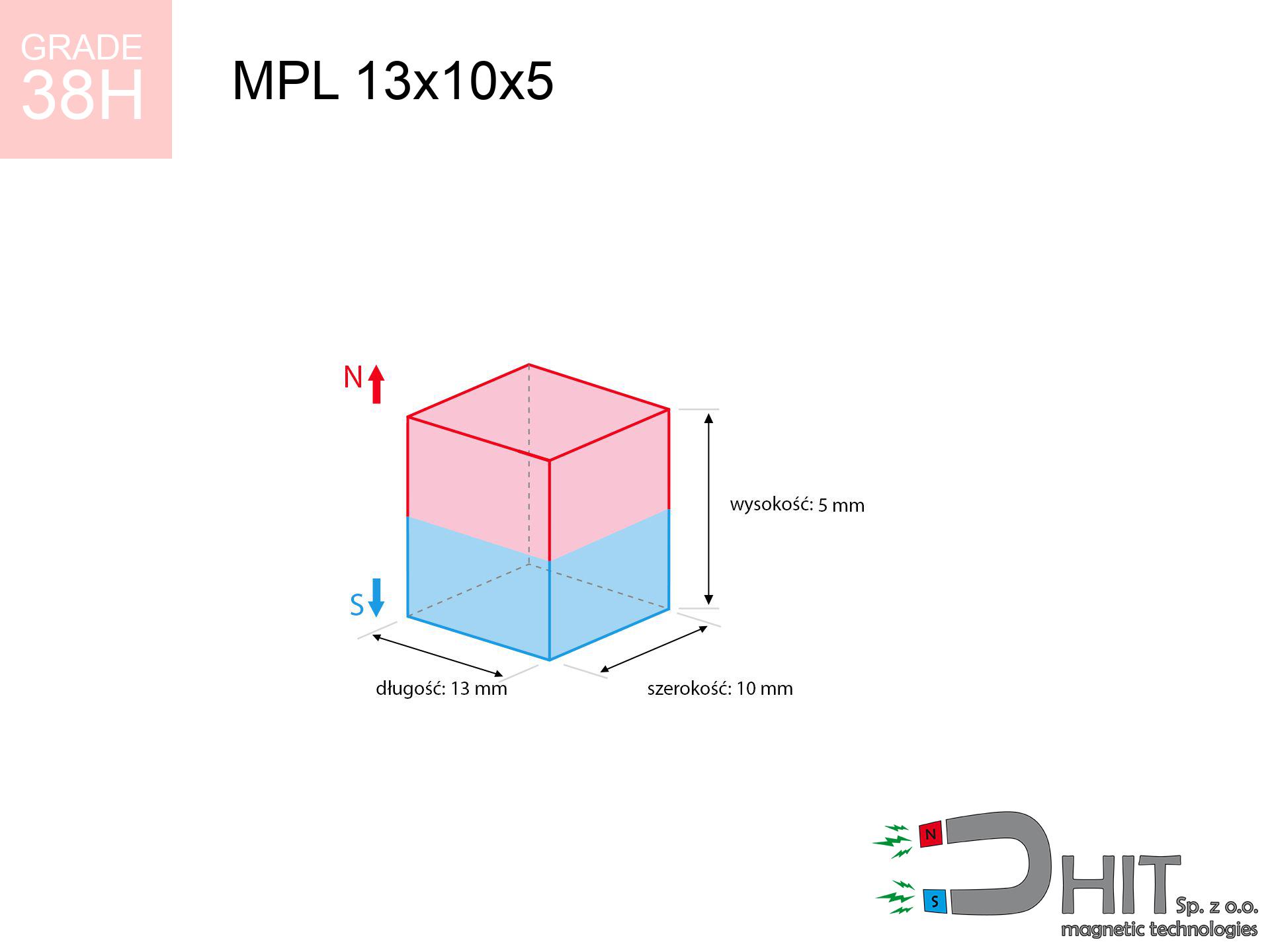MPL 13x10x5 / N35H - lamellar magnet
lamellar magnet
Catalog no 020119
GTIN: 5906301811251
length [±0,1 mm]
13 mm
Width [±0,1 mm]
10 mm
Height [±0,1 mm]
5 mm
Weight
4.88 g
Magnetization Direction
↑ axial
Load capacity
3.38 kg / 33.15 N
Magnetic Induction
369.32 mT
Coating
[NiCuNi] nickel
2.58 ZŁ with VAT / pcs + price for transport
2.10 ZŁ net + 23% VAT / pcs
1.980 ZŁ net was the lowest price in the last 30 days
bulk discounts:
Need more?Need help making a decision?
Pick up the phone and ask
+48 888 99 98 98
if you prefer drop us a message through
inquiry form
our website.
Specifications and appearance of magnets can be checked using our
our magnetic calculator.
Orders placed before 14:00 will be shipped the same business day.
MPL 13x10x5 / N35H - lamellar magnet
Magnetic properties of material N35H
Physical properties of NdFeB
Shopping tips
Thanks to their mighty power, flat magnets are frequently used in devices that need strong holding power.
Most common temperature resistance of these magnets is 80 °C, but depending on the dimensions, this value can increase.
Additionally, flat magnets often have different coatings applied to their surfaces, e.g. nickel, gold, or chrome, for enhancing their corrosion resistance.
The magnet named MPL 13x10x5 / N35H and a magnetic force 3.38 kg with a weight of a mere 4.88 grams, making it the perfect choice for applications requiring a flat shape.
Contact surface: Due to their flat shape, flat magnets guarantee a greater contact surface with other components, which can be beneficial in applications requiring a stronger magnetic connection.
Technology applications: These magnets are often used in different devices, such as sensors, stepper motors, or speakers, where the thin and wide shape is important for their operation.
Mounting: This form's flat shape simplifies mounting, especially when it is necessary to attach the magnet to another surface.
Design flexibility: The flat shape of the magnets permits creators greater flexibility in placing them in devices, which can be more difficult with magnets of more complex shapes.
Stability: In some applications, the flat base of the flat magnet can offer better stability, reducing the risk of sliding or rotating. It’s important to keep in mind that the optimal shape of the magnet is dependent on the specific application and requirements. In certain cases, other shapes, such as cylindrical or spherical, are more appropriate.
Magnets have two poles: north (N) and south (S), which attract each other when they are oppositely oriented. Similar poles, such as two north poles, repel each other.
Due to these properties, magnets are often used in magnetic technologies, e.g. motors, speakers, sensors, or magnetic locks. Neodymium magnets stand out with the highest power of attraction, making them ideal for applications requiring strong magnetic fields. Additionally, the strength of a magnet depends on its dimensions and the materials used.
It should be noted that high temperatures can weaken the magnet's effect. The Curie temperature is specific to each type of magnet, meaning that under such conditions, the magnet stops being magnetic. Interestingly, strong magnets can interfere with the operation of devices, such as compasses, credit cards and even medical equipment, like pacemakers. For this reason, it is important to avoid placing magnets near such devices.
Advantages as well as disadvantages of neodymium magnets NdFeB.
In addition to their tremendous pulling force, neodymium magnets offer the following advantages:
- They have constant strength, and over more than ten years their performance decreases symbolically – ~1% (in testing),
- They show superior resistance to demagnetization from outside magnetic sources,
- Thanks to the shiny finish and gold coating, they have an aesthetic appearance,
- Magnetic induction on the surface of these magnets is notably high,
- They are suitable for high-temperature applications, operating effectively at 230°C+ due to advanced heat resistance and form-specific properties,
- Thanks to the possibility in shaping and the capability to adapt to individual requirements, neodymium magnets can be created in different geometries, which increases their application range,
- Wide application in cutting-edge sectors – they are used in hard drives, rotating machines, healthcare devices and other advanced devices,
- Compactness – despite their small size, they generate strong force, making them ideal for precision applications
Disadvantages of rare earth magnets:
- They are prone to breaking when subjected to a strong impact. If the magnets are exposed to shocks, it is suggested to place them in a steel housing. The steel housing, in the form of a holder, protects the magnet from cracks while also enhances its overall robustness,
- High temperatures may significantly reduce the magnetic power of neodymium magnets. Typically, above 80°C, they experience permanent loss in performance (depending on shape). To prevent this, we offer heat-resistant magnets marked [AH], capable of working up to 230°C, which makes them perfect for high-temperature use,
- Due to corrosion risk in humid conditions, it is wise to use sealed magnets made of synthetic coating for outdoor use,
- Limited ability to create precision features in the magnet – the use of a external casing is recommended,
- Health risk due to small fragments may arise, especially if swallowed, which is crucial in the protection of children. Furthermore, small elements from these magnets can complicate medical imaging if inside the body,
- Due to the price of neodymium, their cost is above average,
Maximum holding power of the magnet – what contributes to it?
The given strength of the magnet means the optimal strength, determined in ideal conditions, namely:
- using a steel plate with low carbon content, serving as a magnetic circuit closure
- having a thickness of no less than 10 millimeters
- with a polished side
- in conditions of no clearance
- in a perpendicular direction of force
- at room temperature
Lifting capacity in practice – influencing factors
In practice, the holding capacity of a magnet is conditioned by the following aspects, from crucial to less important:
- Air gap between the magnet and the plate, since even a very small distance (e.g. 0.5 mm) causes a drop in lifting force of up to 50%.
- Direction of applied force, because the maximum lifting capacity is achieved under perpendicular application. The force required to slide the magnet along the plate is usually several times lower.
- Thickness of the plate, as a plate that is too thin causes part of the magnetic flux not to be used and to remain wasted in the air.
- Material of the plate, because higher carbon content lowers holding force, while higher iron content increases it. The best choice is steel with high magnetic permeability and high saturation induction.
- Surface of the plate, because the more smooth and polished it is, the better the contact and consequently the greater the magnetic saturation.
- Operating temperature, since all permanent magnets have a negative temperature coefficient. This means that at high temperatures they are weaker, while at sub-zero temperatures they become slightly stronger.
* Holding force was tested on a smooth steel plate of 20 mm thickness, when the force acted perpendicularly, however under parallel forces the holding force is lower. In addition, even a slight gap {between} the magnet and the plate decreases the load capacity.
Caution with Neodymium Magnets
Neodymium magnets can demagnetize at high temperatures.
Even though magnets have been observed to maintain their efficacy up to temperatures of 80°C or 175°F, it's essential to consider that this threshold may fluctuate depending on the magnet's type, configuration, and intended usage.
Comparing neodymium magnets to ferrite magnets (found in speakers), they are 10 times more powerful, and their power can surprise you.
To use magnets properly, it is best to familiarize yourself with our information beforehand. This will help you avoid significant harm to your body and the magnets themselves.
Never bring neodymium magnets close to a phone and GPS.
Neodymium magnets are a source of intense magnetic fields that cause interference with magnetometers and compasses used in navigation, as well as internal compasses of smartphones and GPS devices.
Keep neodymium magnets away from people with pacemakers.
Neodymium magnets produce strong magnetic fields that can interfere with the operation of a heart pacemaker. Even if the magnetic field does not affect the device, it can damage its components or deactivate the entire device.
Magnets are not toys, youngest should not play with them.
Neodymium magnets are not toys. You cannot allow them to become toys for children. In the case of small magnets, they can be swallowed and cause choking. In such cases, the only solution is to undergo surgery to remove the magnets, and otherwise, it can even lead to death.
The magnet coating contains nickel, so be cautious if you have a nickel allergy.
Studies clearly indicate a small percentage of people who suffer from metal allergies such as nickel. An allergic reaction often manifests as skin redness and rash. If you have a nickel allergy, try wearing gloves or avoid direct contact with nickel-plated neodymium magnets.
It is crucial not to allow the magnets to pinch together uncontrollably or place your fingers in their path as they attract to each other.
If joining of neodymium magnets is not under control, then they may crumble and crack. Remember not to move them to each other or have them firmly in hands at a distance less than 10 cm.
Make sure not to bring neodymium magnets close to the TV, wallet, and computer HDD.
Neodymium magnets produce intense magnetic fields that can destroy magnetic media such as floppy disks, video tapes, HDDs, credit cards, magnetic ID cards, cassette tapes, etc. devices. They can also destroy devices like video players, televisions, CRT computer monitors. Do not forget to keep neodymium magnets at a safe distance from these electronic devices.
Dust and powder from neodymium magnets are flammable.
Avoid drilling or mechanical processing of neodymium magnets. If the magnet is crushed into fine powder or dust, it becomes highly flammable.
Neodymium magnets are known for their fragility, which can cause them to shatter.
Neodymium magnetic are highly fragile, and by joining them in an uncontrolled manner, they will crack. Neodymium magnetic are made of metal and coated with a shiny nickel, but they are not as durable as steel. In the event of a collision between two magnets, there may be a scattering of fragments in different directions. Protecting your eyes is crucial in such a situation.
Safety precautions!
To raise awareness of why neodymium magnets are so dangerous, read the article titled How dangerous are powerful neodymium magnets?.







![UMP 75x25 [M10x3] GW F200 GOLD Lina / N42 - search holder UMP 75x25 [M10x3] GW F200 GOLD Lina / N42 - search holder](https://cdn3.dhit.pl/graphics/products/ump-75x25-m10x3-gw-f200-gold-lina-buh.jpg)

